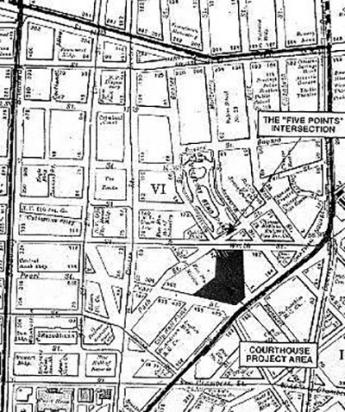
A map of Manhattan’s Sixth Ward, highlighting the Five Points intersection and the Courthouse Block project area
A “mythic slum”
Five Points is New York City’s mythic slum. Named for the points created by the intersection of Park, Worth, and Baxter streets, the neighborhood was known as a center of vice and debauchery throughout the nineteenth century. Outsiders found Five Points threatening and fodder for lurid prose.
Describing a visit in 1842, Charles Dickens wrote: “This is the place: these narrow ways diverging to the right and left, and reeking every where with dirt and filth. Such lives as are led here, bear the same fruit here as elsewhere. The coarse and bloated faces at the doors have counterparts at home and all the wide world over. Debauchery has made the very houses prematurely old. See how the rotten beams are tumbling down, and how the patched and broken windows seem to scowl dimly, like eyes that have been hurt in drunken frays. Many of these pigs live here. Do they ever wonder why their masters walk upright in lieu of going on all-fours? and why they talk instead of grunting?”
The archaeological excavation of the Foley Square Courthouse block provided the opportunity to examine the physical remains of life in this infamous place. This virtual exhibit begins to tell the story of what was found.
Frightening slum or thriving neighborhood?
To outsiders, Five Points was a frightening slum; from the inside it was a thriving working-class neighborhood. Through the study of the artifacts recovered in 1991, the daily lives of the people who lived at Five Points become visible. A team of 17 archaeologists, conservators, and historians is currently analyzing the 850,000 artifacts recovered from the Foley Square courthouse block. Out of the analysis will come a richer story about the working-class residents of Five Points, the neighborhood’s reputation as New York’s most notorious slum, and its overcrowded tenement neighborhood teeming with newly arrived immigrants struggling to succeed in an alien city.
Backyard features (abandoned privy shafts, cisterns, wells) subsequently used as trash repositories are often the focus of urban archaeology. A wealth of information can be derived from people’s garbage — information about their private lives, their personal choices, and even their political allegiances.

 U.S. General Services Administration
U.S. General Services Administration
